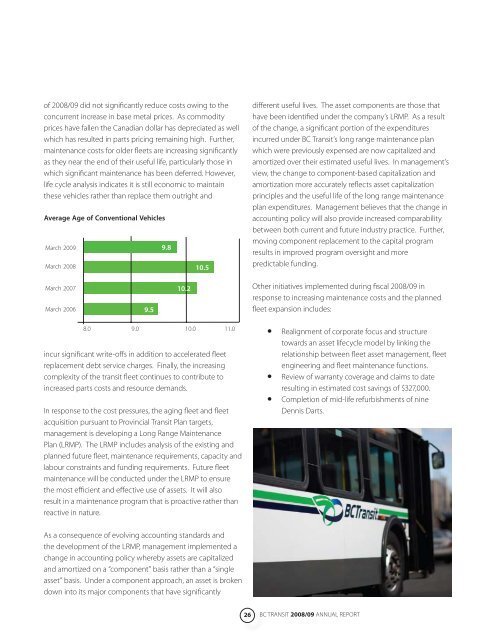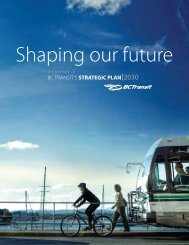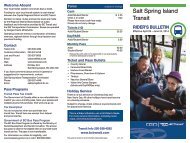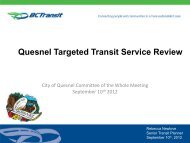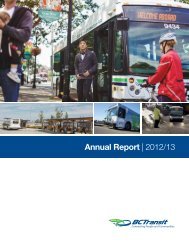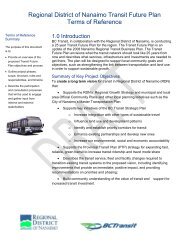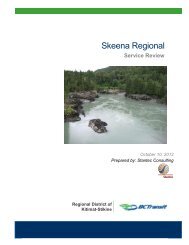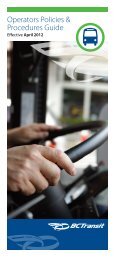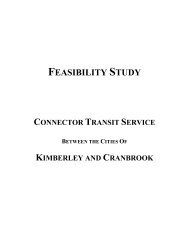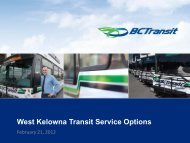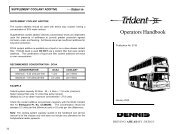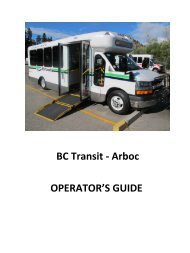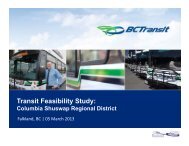ANNUAL REPORT 2008/09 - BC Transit
ANNUAL REPORT 2008/09 - BC Transit
ANNUAL REPORT 2008/09 - BC Transit
- No tags were found...
You also want an ePaper? Increase the reach of your titles
YUMPU automatically turns print PDFs into web optimized ePapers that Google loves.
of <strong>2008</strong>/<strong>09</strong> did not significantly reduce costs owing to theconcurrent increase in base metal prices. As commodityprices have fallen the Canadian dollar has depreciated as wellwhich has resulted in parts pricing remaining high. Further,maintenance costs for older fleets are increasing significantlyas they near the end of their useful life, particularly those inwhich significant maintenance has been deferred. However,life cycle analysis indicates it is still economic to maintainthese vehicles rather than replace them outright andAverage Age of Conventional VehiclesMarch 20<strong>09</strong>March <strong>2008</strong>9.810.5different useful lives. The asset components are those thathave been identified under the company’s LRMP. As a resultof the change, a significant portion of the expendituresincurred under <strong>BC</strong> <strong>Transit</strong>’s long range maintenance planwhich were previously expensed are now capitalized andamortized over their estimated useful lives. In management’sview, the change to component-based capitalization andamortization more accurately reflects asset capitalizationprinciples and the useful life of the long range maintenanceplan expenditures. Management believes that the change inaccounting policy will also provide increased comparabilitybetween both current and future industry practice. Further,moving component replacement to the capital programresults in improved program oversight and morepredictable funding.March 2007March 20069.510.2Other initiatives implemented during fiscal <strong>2008</strong>/<strong>09</strong> inresponse to increasing maintenance costs and the plannedfleet expansion includes:8.0 9.0 10.0 11.0incur significant write-offs in addition to accelerated fleetreplacement debt service charges. Finally, the increasingcomplexity of the transit fleet continues to contribute toincreased parts costs and resource demands.In response to the cost pressures, the aging fleet and fleetacquisition pursuant to Provincial <strong>Transit</strong> Plan targets,management is developing a Long Range MaintenancePlan (LRMP). The LRMP includes analysis of the existing andplanned future fleet, maintenance requirements, capacity andlabour constraints and funding requirements. Future fleetmaintenance will be conducted under the LRMP to ensurethe most efficient and effective use of assets. It will alsoresult in a maintenance program that is proactive rather thanreactive in nature.••Realignment of corporate focus and structuretowards an asset lifecycle model by linking therelationship between fleet asset management, fleetengineering and fleet maintenance functions.••Review of warranty coverage and claims to dateresulting in estimated cost savings of $327,000.••Completion of mid-life refurbishments of nineDennis Darts.As a consequence of evolving accounting standards andthe development of the LRMP, management implemented achange in accounting policy whereby assets are capitalizedand amortized on a “component” basis rather than a “singleasset” basis. Under a component approach, an asset is brokendown into its major components that have significantly26<strong>BC</strong> TRANSIT <strong>2008</strong>/<strong>09</strong> <strong>ANNUAL</strong> <strong>REPORT</strong>


